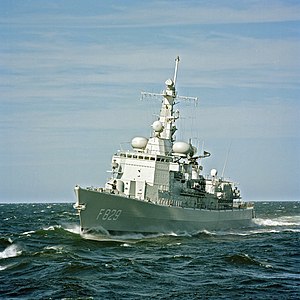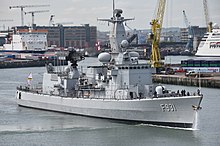The Royal Netherlands Navy is the maritime service branch of the Netherlands Armed Forces. It was founded on 8 January 1488, making it the third-oldest naval force in the world.

HNLMS Van Speijk (F828) is the eighth and last ship in the Karel Doorman class of multi-purpose frigates, used by the Royal Netherlands Navy.
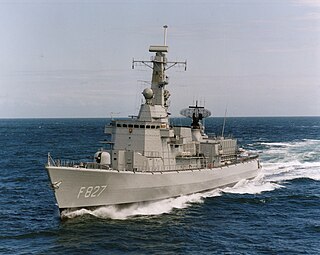
Leopold I (F930) is a Karel Doorman-class frigate of the Marine Component of the Belgian Armed Forces. Prior to 29 March 2007, the ship was known as HNLMS Karel Doorman (F827). It is one of the two frigates of this class purchased from the Royal Netherlands Navy on 22 December 2005.

The Karel Doorman-class frigates are a series of eight multi-purpose vessels built for the Royal Netherlands Navy. Its namesake is Karel Doorman, a Dutch naval officer whose ship was struck by a Japanese torpedo in the Battle of the Java Sea in 1942, and went down with his ship as a result.

Willem van der Zaan was a Dutch Admiral. His name is often given in the 17th century spelling Zaen.

The Belgian Navy, officially the Naval Component of the Belgian Armed Forces, is the naval service of Belgium.

HNLMS Tromp (F803) is the second De Zeven Provinciën-class frigate of the Royal Netherlands Navy. The ship was laid down in 1999, launched in 2001, and commissioned in 2003. The frigate is named after Dutch naval heroes Maarten Tromp (1598–1653) and Cornelis Tromp (1629–1691).
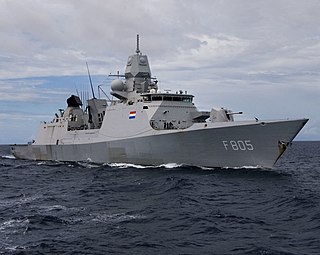
HNLMS Evertsen (F805) is the fourth De Zeven Provinciën-class frigate of the Royal Netherlands Navy.

HNLMS Karel Doorman is a multi-function support ship for amphibious operations of the Royal Netherlands Navy, which is also used by the German Navy. The ship replaced both of the navy's replenishment oilers: HNLMS Zuiderkruis and HNLMS Amsterdam. At 204.7 m she is the largest ship in service with the Royal Netherlands Navy.
Two ships of the Royal Netherlands Navy have been named HNLMS Willem van der Zaan in honour of the 17th century Schout-bij-nacht Willem Van Der Zaan.

HNLMS Willem van der Zaan (ML-2/N82/F824/A880) was a minelayer of the Royal Netherlands Navy that was commissioned only days before the start of World War II in September 1939. She served in England, in the Netherlands East Indies, and as a convoy escort in the Indian Ocean before returning to The Netherlands in 1945. She then served again in the Netherlands East Indies and Dutch West Indies until 1950 when she was rebuilt and reclassified as a frigate. From 1961 she was used as an accommodation and repair ship until struck in 1970 and sold for scrap. She was named in honour of the 17th century Schout-bij-nacht Willem van der Zaan.

The Anti-Submarine Warfare Frigate (ASWF) is a project of the Royal Netherlands Navy and Belgian Navy to replace the existing Multipurpose- or M-frigates. The project shows similarities to the British Global Combat Ship but development is fully separate.
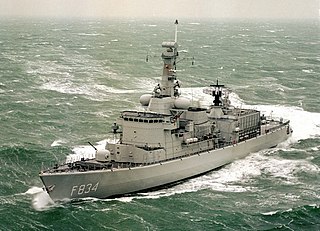
HNLMS Van Galen (F834) is a ship of the Karel Doorman class of multi-purpose frigates of the Royal Netherlands Navy. Built by the shipyard Koninklijke Schelde Groep in Vlissingen. The ship is named after captain and convoy commander Johan van Galen and served from 1994 to 2008 with the Dutch navy. The radio call sign of the frigate was "PAMG". In 2009 HNLMS Van Galen was sold to Portugal. The ship was transferred in 2010 to the Portuguese Navy, where the ship was put into service as the NRP Dom Francisco de Almeida (F334).

HNLMS Tromp (F801) was a frigate of the Tromp class. The ship was in service with the Royal Netherlands Navy from 1975 to 1999. The frigate was named after Dutch naval hero Tromp. The ship's radio call sign was "PADE".

HNLMS Jacob van Heemskerck (F812) was a frigate of the Jacob van Heemskerck class. The ship was in service with the Royal Netherlands Navy from 1986 to 2004. The frigate was named after Dutch naval hero Jacob van Heemskerck. The ship's radio call sign was "PAVO".

HNLMS Bloys van Treslong (F824) was a frigate of the Kortenaer class. The ship was in service with the Royal Netherlands Navy from 1982 to 2003. The frigate was named after Dutch naval hero Willem Bloys van Treslong. The ship's radio call sign was "PADG".
In April 2018, the Dutch Government approved a multi-year investment program for the Royal Netherlands Navy and allocated funds for the 2018–2030 period. The Dutch Defence Materiel Administration (DMO) is in charge of the procurement of these new ships.

The Netherlands and Belgium are doing a joint procurement for the replacements of the Tripartite-class/Alkmaar-class minehunters. Each of the two countries is procuring six new mine countermeasure (MCM) vessels, which makes for a total of 12 MCM ships. The new MCM ships, developed by Naval Group, will include a range of unmanned systems including unmanned surface, aerial and underwater vehicles alongside towed sonars and mine identification and neutralization remotely operated vehicles.

Operation Aspides, also known as EUNAVFOR Aspides, is an EU military operation in response to Houthi engagements with international shipping in the Red Sea. Named after the Greek word for shields, Operation Aspides—unlike the US-led Operation Prosperity Guardian—is a "purely defensive" mission to increase maritime surveillance in the region, provide escort to merchant vessels, and defend against strikes.
